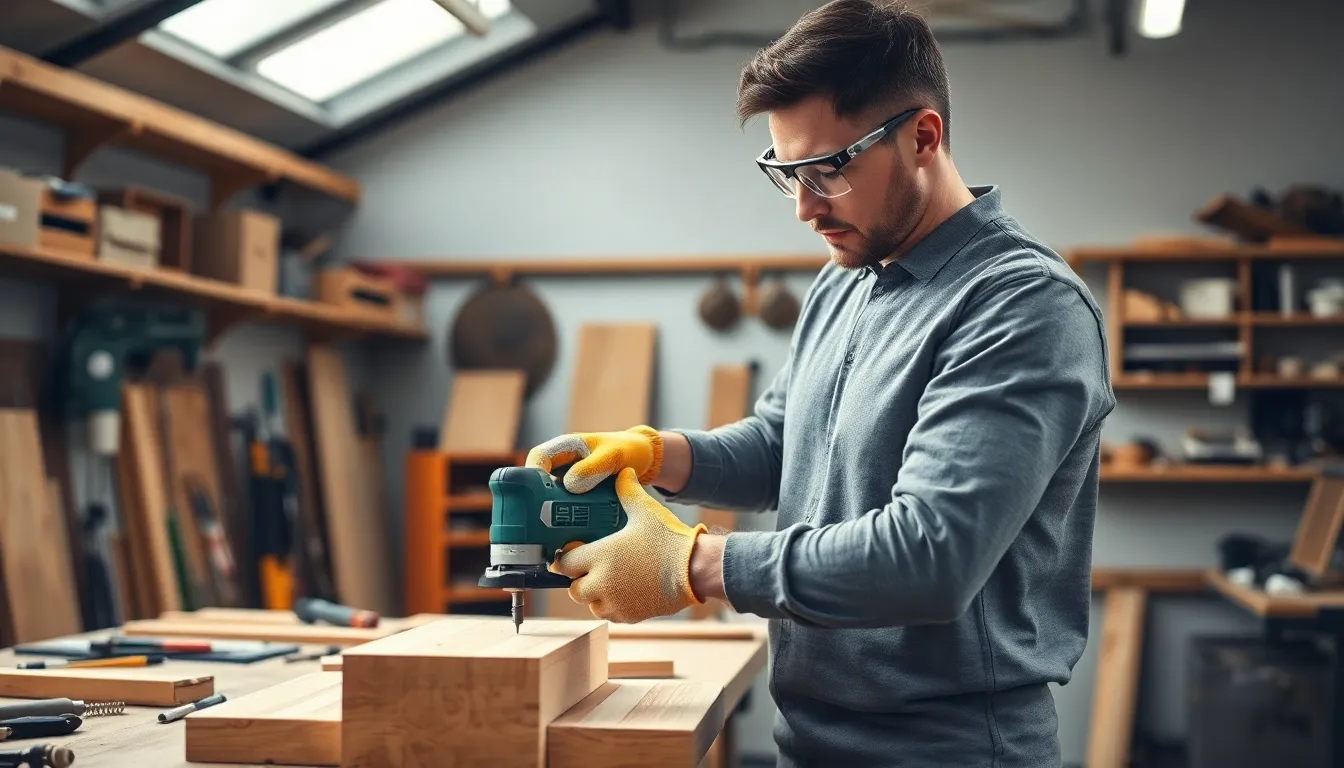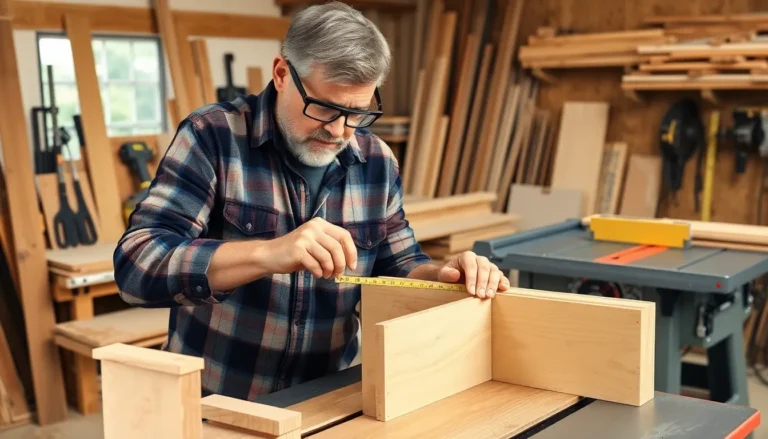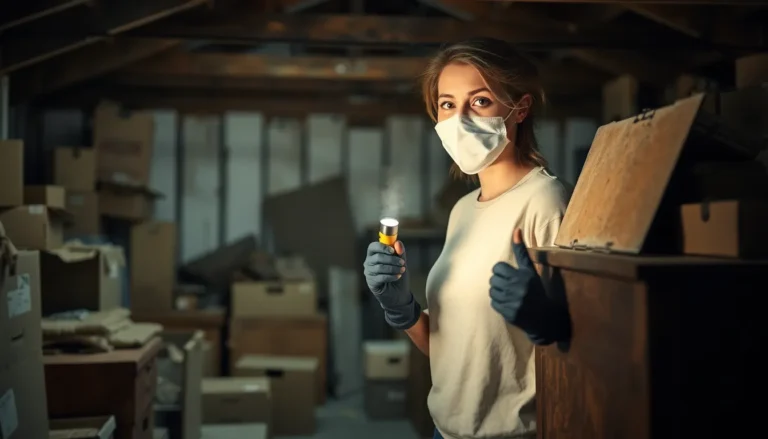When it comes to DIY projects, nothing feels quite as satisfying as transforming a space with your own two hands. But let’s face it—nothing ruins a home improvement spree faster than a trip to the ER. Safety might not be the most exciting part of your project, but it’s the unsung hero that keeps your fingers intact and your sanity in check.
Table of Contents
ToggleImportance Of DIY Safety Tips
Safety plays a crucial role in DIY projects. Neglecting safety can result in serious injuries or accidents. Every DIY enthusiast should recognize the risks involved, from minor cuts to severe falls. Following safety tips helps minimize these risks significantly.
Protective gear constitutes a fundamental aspect of safety. Wearing goggles shields the eyes from dust and debris. Gloves safeguard hands against sharp tools and materials. Ear protection can prevent damage from loud equipment. Each item of safety equipment reduces the likelihood of injury.
Proper tool handling serves as another essential safety measure. Knowing how to use tools correctly ensures efficiency and reduces the chance of accidents. Familiarity with tool functions promotes confidence during use. Maintaining equipment in good condition also contributes to safer operations.
Workspace organization enhances safety too. Keeping the workspace tidy minimizes tripping hazards. Storing tools properly reduces the chances of injury when reaching for them. Clear pathways make movement easier and safer during a project.
Awareness of surroundings cannot be overlooked. Identifying potential hazards in the workspace enables proactive measures. Ensuring adequate ventilation while working with chemicals prevents respiratory issues. Staying alert while working helps avoid distractions that may lead to accidents.
Prioritizing DIY safety tips is vital for a successful project outcome. Combining protective gear, proper tool handling, workspace organization, and awareness fosters a safer DIY environment. Every small step taken to improve safety contributes to overall well-being during home improvement tasks.
Common Risks In DIY Projects

DIY projects come with several risks that require awareness and preparation. Safety measures can minimize potential hazards and contribute to successful outcomes.
Tools And Equipment Safety
Sharp tools pose a significant risk in DIY workspaces. Ensure all cutting tools receive regular maintenance and inspections for safe operation. Power tools require training for proper usage. Follow the manufacturer’s guidelines to avoid accidents. Using guards and safety switches on equipment helps prevent injuries. Storing tools in secure locations and away from children is crucial for maintaining a safe environment. Wearing appropriate protective gear, such as gloves and goggles, further enhances safety during tool usage.
Hazardous Materials Awareness
Exposure to hazardous materials can lead to serious health risks. Identifying harmful substances like paints, solvents, and cleaning agents enhances safety measures. Always read labels for safety data and follow guidelines during usage. Ensure proper ventilation when working with chemicals, as fumes can become dangerous. Using masks, gloves, and goggles provides additional protection against toxic exposure. Keeping hazardous materials out of reach of children remains essential for a safer workspace. Proper disposal methods for these materials also safeguard both personal and environmental health.
Essential DIY Safety Tips
Prioritizing safety during DIY projects is crucial for achieving success and preventing accidents. He or she should keep a few essential tips in mind.
Personal Protective Equipment
Selecting appropriate personal protective equipment (PPE) remains vital. Goggles protect the eyes from dust and debris. Gloves guard against cuts and chemical exposure. Hearing protection protects against noise from power tools. Wearing a dust mask prevents inhalation of harmful particles. Investing in quality PPE increases safety significantly. Together, these items create a robust defense against potential injuries.
Safe Working Environment
Creating a safe working environment enhances overall safety during DIY projects. Organizing the workspace reduces clutter and minimizes trip hazards. Adequate lighting allows for better visibility of tools and materials. Ensuring proper ventilation is crucial, especially when working with hazardous substances. Avoiding distractions, such as phone use, keeps sharp focus on the task. Stable positioning of ladders and equipment contributes to a more secure experience. Combining these elements fosters a more efficient and safe project execution.
Planning And Preparation
Planning and preparation set the foundation for a safe DIY project. These steps ensure a smoother process while minimizing risks.
Assessing The Project Site
Evaluating the project site helps identify potential hazards. Inspect the area for sharp objects, uneven surfaces, or obstacles that could cause trips. Clear away clutter to enhance accessibility. Adequate lighting plays a significant role in preventing accidents. Ensure all electrical sources are safe and in good condition. Mark off high-risk zones, especially when using power tools. Adequate preparation includes assessing the weather when working outdoors. Gathering this information creates a safer environment for work.
Gathering Necessary Supplies
Collecting essential supplies promotes a secure working atmosphere. Prioritize quality tools, as damaged equipment can lead to accidents. Ensure the availability of personal protective equipment like gloves and goggles. Stock up on safety gear tailored to specific tasks, such as hearing protection or dust masks for renovation work. Organize tools before starting to avoid confusion and inefficiency during the project. Check that all materials comply with safety regulations, particularly hazardous substances. Being well-prepared reduces the likelihood of interruptions and enhances overall project safety.
Emergency Preparedness
Emergency preparedness serves as a vital component of DIY safety. It ensures that individuals can respond effectively to accidents or injuries.
First Aid Measures
Equipping a first aid kit enhances safety during DIY projects. Kits should include band-aids, antiseptic wipes, gauze pads, and adhesive tape. He or she should also consider adding scissors and tweezers. Familiarity with basic first aid can prove beneficial. Learning to treat cuts, scrapes, and minor burns helps in managing injuries instantly. For serious injuries, knowing when to call for professional medical help is equally crucial. Keeping emergency numbers visible and accessible contributes to a proactive approach.
Emergency Contacts
Listing emergency contacts is essential in any DIY safety plan. Individuals should include local emergency services, healthcare providers, and trusted friends or family members who can assist. Posting this list in a prominent location, such as near the workspace or on the fridge, ensures quick access. Establishing a communication plan allows for swift notification in case of accidents. Reviewing and updating these contacts periodically keeps information relevant and accessible. Each DIY enthusiast must prioritize emergency contacts, ensuring they can react efficiently if the situation arises.
Prioritizing safety in DIY projects is essential for a successful and enjoyable experience. By implementing the safety tips discussed, individuals can significantly reduce the risk of accidents and injuries. Wearing the right protective gear and maintaining tools ensures a safer working environment.
Planning and preparation play a crucial role in identifying potential hazards and establishing a secure workspace. Moreover, being prepared for emergencies can make all the difference in managing unexpected situations.
With these practices in mind, DIY enthusiasts can confidently tackle their projects while keeping safety at the forefront. A commitment to safety not only protects individuals but also enhances the overall quality of their home improvement endeavors.



